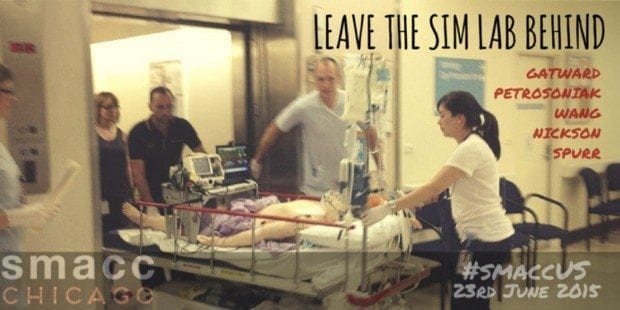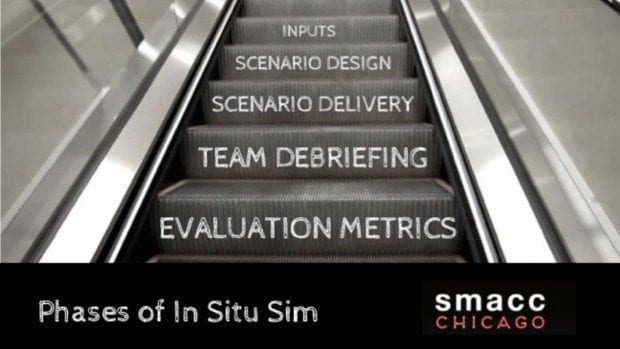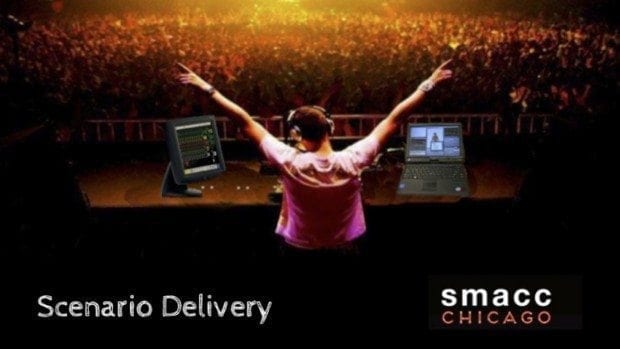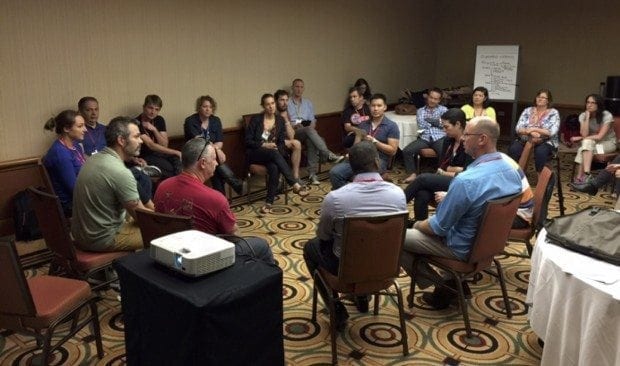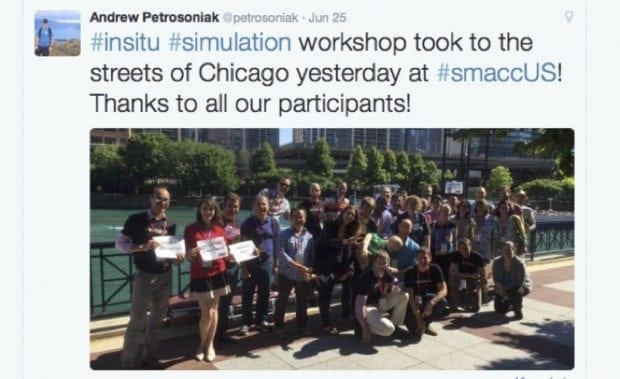Leave the Sim Lab Behind
This is a guest post by Jesse Spurr (@inject_orange)
On the afternoon of the 23rd June the inaugural SMACC Leave the Sim Lab Behind workshop was held.
A dream team (Editor’s note: team of dreamers?) was assembled to help participants take simulation into their workplace:
- Dr Jon Gatward @jgatward
- Dr Chris Nickson @precordialthump
- Dr Andrew Petrosoniak @petrosoniak
- Dr Ernie Wang @Dr_Commonsense
- Jesse Spurr @inject_orange
We were very ably assisted by volunteers Ali Gould (@intransition2) and Laura Raiti (@lauraraiti). Dr Clare Desmond (@domerdr and Simulation Fellow at NorthShore University HealthSystem) provided equipment and logistical support. We would also like to thank iSimulate and Laerdal USA for loaning the simulators for the workshop.
Following an overarching pre-brief, the format of the workshop was established. The concept of Phases of In Situ Sim was used as a linear structure through which we danced the dance of simulation.
The workshop started with each of the facilitators giving an example of an input that had fuelled their own sim experiences.
- Dr Jon Gatward – Addressing M&M: The Chest Re-open in Cardiothoracic ICU
- Dr Chris Nickson – Team Roles and Functions in ECPR
- Dr Andrew Petrosoniak – Procedural Skills Competence: Cricothyroidotomy
- Dr Ernie Wang – Precipitous Birth and Obstetric Emergency in the ED
- Jesse Spurr – Finding Latent Risk in Hospital Wide Medical Emergency Program
The Sheraton Towers Hotel, host to the smaccUS pre-conference workshops had set the remit of the SMACC simulation service (our workshop participants) to design four scenarios to test the contracted private emergency medical response team hired to protect the hotel from litigation (Plausible? It is America!).
- Drowning +/- inebriation
- Traumatic fall down stairs/escalator
- Choking in restaurant
- Psychotic episode triggered by a delegate realising he had missed Cliff Reid speaking because he had stayed to listen to Roger Harris.
Participants were split into four teams, each with a coach, and given a scenario template (download here) to develop and present back to the whole group.
After a quick break Jon Gatward gave some lessons learned in establishing an In Situ Simulation program, while the sim ninjas went to set up for the Drowning Sim.
Potential arrest, prosecution, and rough nights in the slammer were avoided by expert prior planning and hazard identification. We were soon able to state that SMACC US was proudly supported by the Chicago PD (thumbs up and wave – not formal endorsement).
Then it was show time. The team that had designed the Drowning scenario ran a highly immersive (pardon the pun) simulation for the team that had won the best scenario design to participate as the SMACC medical team.
Then it was show time. The team that had designed the Drowning scenario ran a highly immersive (pardon the pun) simulation for the team that had won the best scenario design to participate as the SMACC medical team.
Following some relaxing time in the sun, we ventured back into the debrief space for the sim team to practice the deft arts of venting emotions, unpacking frames, and making the most of teachable moments.
Following the debrief, we got all ‘meta’ and debriefed the debriefers, leading to some great discussion and referring to some excellent debriefing aides and resources (see Debrief on Mobilesim)
Like all good workshops, Leave the Sim Lab Behind came to an end. Unfortunately we had to truncate the session on evaluation and metrics. In summary, the key priority is to link the sim program to organisational goals. If adverse clinical events, clinical audit, complaints, or new services are highlighted as risks, develop scenarios to address these and then report the outcomes – loud and proud. Articulate scenario outcomes to department leads, hospital administrators, safety and quality groups, the world. Get traction to keep running great simulation. If you are not seeing wins, maybe rethink your ‘Inputs’ and go back to the start of the program development.
Also don’t underestimate the often maligned participant feedback surveys. While not of huge educational rigour, Jon Gatward emphasized that strong participant satisfaction and enjoyment of the training (graphically displayed for ‘management’) was enough to allow his program to get a foothold and a small budget to enhance the training capacity.
So on that note, thank you for an awesome workshop, we really enjoyed it!
Thanks finally to the most important people, the participants. You all suspended disbelief, placed trust and opened up to an amazing learning experience.
Recommended resources
- LITFL CCC — In situ simulation (overview of pros and cons and safety issues in in situ simulation)
- Simulating Healthcare Blog (brilliant blog by Dr Paul E. Phrampus, a guru in the world of healthcare simulation)
- ICN — Guerilla Sim: Anyone, anytime, Anywhere (Jon Gatward’s talk at SMACC 2013)
- KI Docs — Guerilla Sim taking off… (Tim Leeuwenburg’s in situ overview) and his excellent Simulation apps review
- MobileSim (Jon Gatward’s excellent in situ simulation website including guides, templates and scenarios)
- Sim and Choppers – Ten Commandments of In Situ Sim (Top tips from Andrew Petrosoniak)
- St Emlyn’s – Top Ten Tips for In Situ Sim (a great blog and podcast post giving ten solid tips about integrating simulation into your workplace education program)
- Injectable Orange – Simulation Basics – Back to the Future (a casual walkthrough podcast reflecting on the phases of simulation)
- INTENSIVE – ICU-IS-SIM (resources for the in situ simulation program at The Alfred ICU, including scenarios)
Chris is an Intensivist and ECMO specialist at The Alfred ICU, where he is Deputy Director (Education). He is a Clinical Adjunct Associate Professor at Monash University, the Lead for the Clinician Educator Incubator programme, and a CICM First Part Examiner.
He is an internationally recognised Clinician Educator with a passion for helping clinicians learn and for improving the clinical performance of individuals and collectives. He was one of the founders of the FOAM movement (Free Open-Access Medical education) has been recognised for his contributions to education with awards from ANZICS, ANZAHPE, and ACEM.
His one great achievement is being the father of three amazing children.
On Bluesky, he is @precordialthump.bsky.social and on the site that Elon has screwed up, he is @precordialthump.
| INTENSIVE | RAGE | Resuscitology | SMACC

